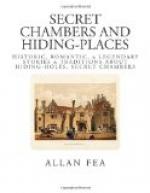The old French chateaux, according to Froisart, were rarely without secret means of escape. King Louis XVI., famous for his mechanical skill, manufactured a hiding-place in an inner corridor of his private apartments at the Palace of Versailles. The wall where it was situated was painted to imitate large stones, and the grooves of the opening were cleverly concealed in the shaded representations of the divisions. In this a vast collection of State papers was preserved prior to the Revolution.[1]
[Footnote 1: Vide The Memoirs of Madame Campan.]
Mr. Lang tells us, in his admirable work Pickle the Spy, that Bonnie Prince Charlie, between the years 1749 and 1752, spent much of his time in the convent of St. Joseph in the Rue St. Dominique, in the Faubourg St. Germain, which under the late Empire (1863) was the hotel of the Minister of War. Here he appears to have been continually lurking behind the walls, and at night by a secret staircase visiting his protectress Madame de Vasses. Allusion is made in the same work to a secret cellar with a “dark stair” leading to James III.’s furtive audience-chamber at his residence in Rome.
So recently as the year 1832 a hiding-place in an old French house was put to practical use by the Duchesse de Berry after the failure of her enterprise to raise the populace in favour of her son the Duc de Bordeaux. She had, however, to reveal herself in preference to suffocation, a fire, either intentionally or accidentally, having been ignited close to where she was hidden, recalling the terrible experiences of Father Gerard at “Braddocks.”
CHAPTER XVI
THE SCOTTISH HIDING-PLACES OF PRINCE CHARLES EDWARD
The romantic escapes of Prince Charles Edward are somewhat beyond the province of this book, owing to the fact that the hiding-places in which he lived for the greater part of five months were not artificial but natural formations in the wild, mountainous country of the Western Highlands. Far less convenient and comfortable were these caves and fissures in the rocks than those secret places which preserved the life of the “young chevalier’s” great-uncle Charles II. Altogether, the terrible hardships to which the last claimant to the Stuart throne was subjected were far greater in every way, and we can but admire the remarkable spirit, fortitude, and courage that carried him through his numerous dangers and trials.
The wild and picturesque character not only of the Scotch scenery, but of the loyal Highlanders, who risked their all to save their King, gives the story of this remarkable escape a romantic colouring that surpasses any other of its kind, whether real or fictitious.
This, therefore, is our excuse for giving a brief summary of the Prince’s wanderings, if only to add to our other hiding-places a record of the names of the isolated spots which have become historical landmarks.




